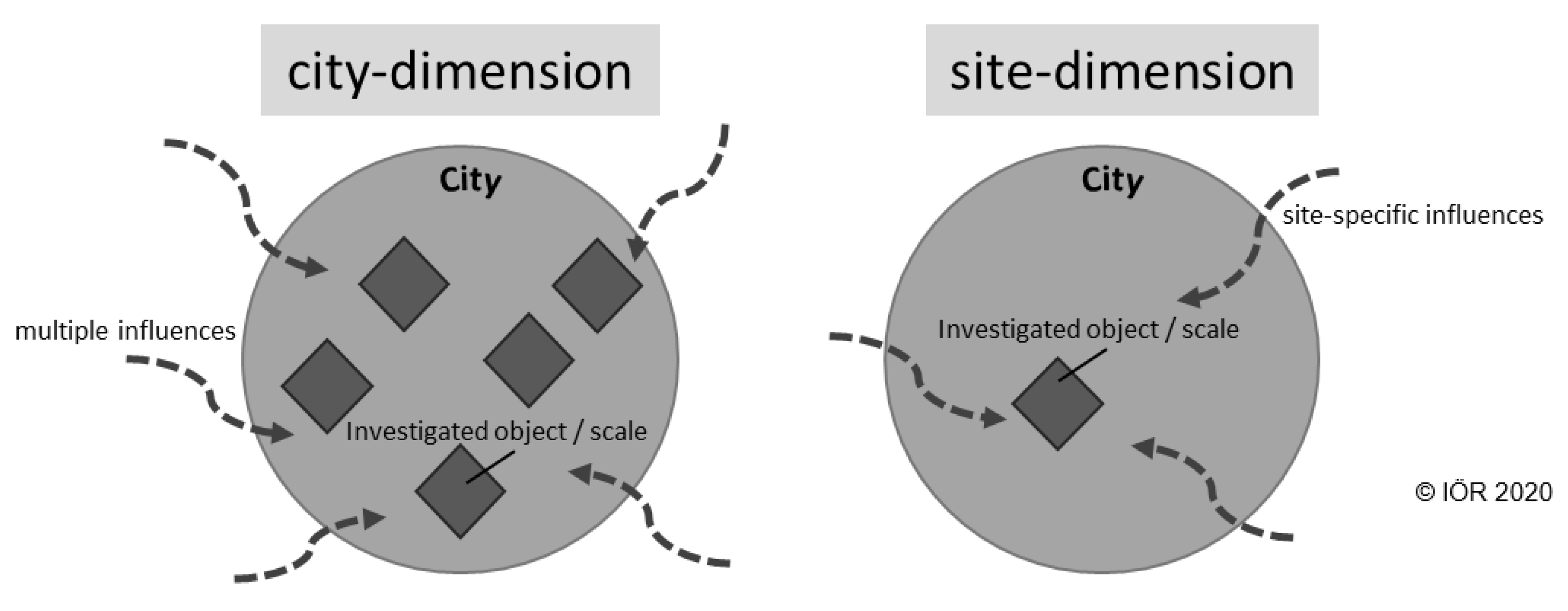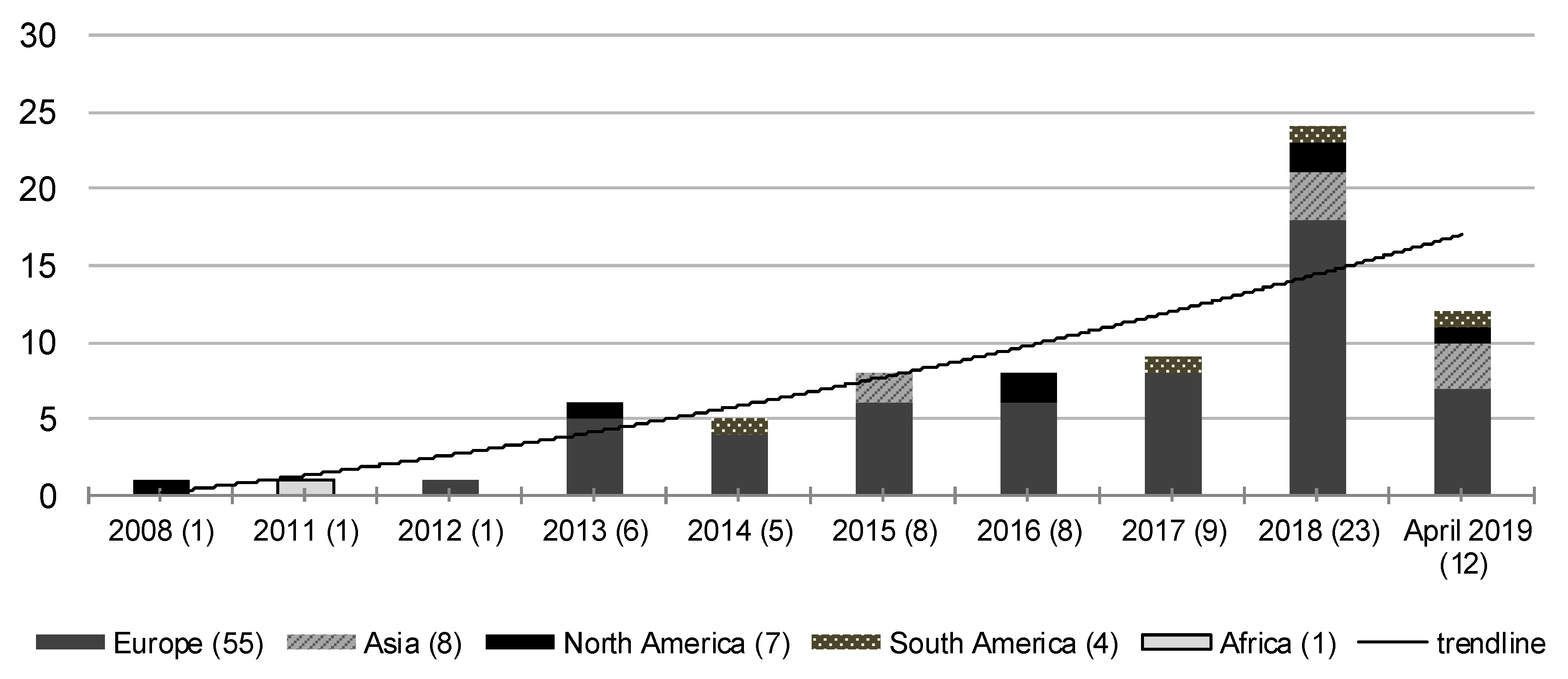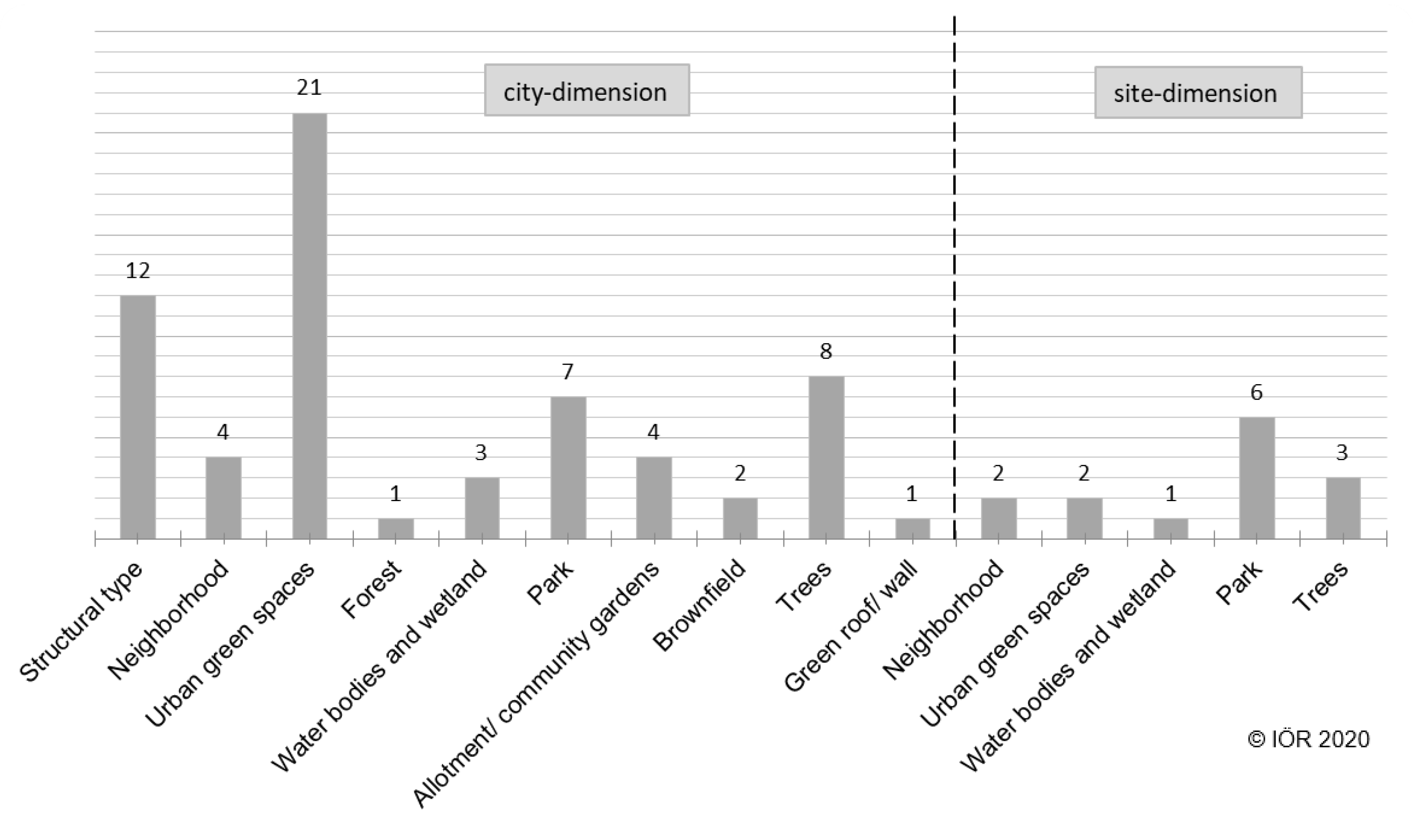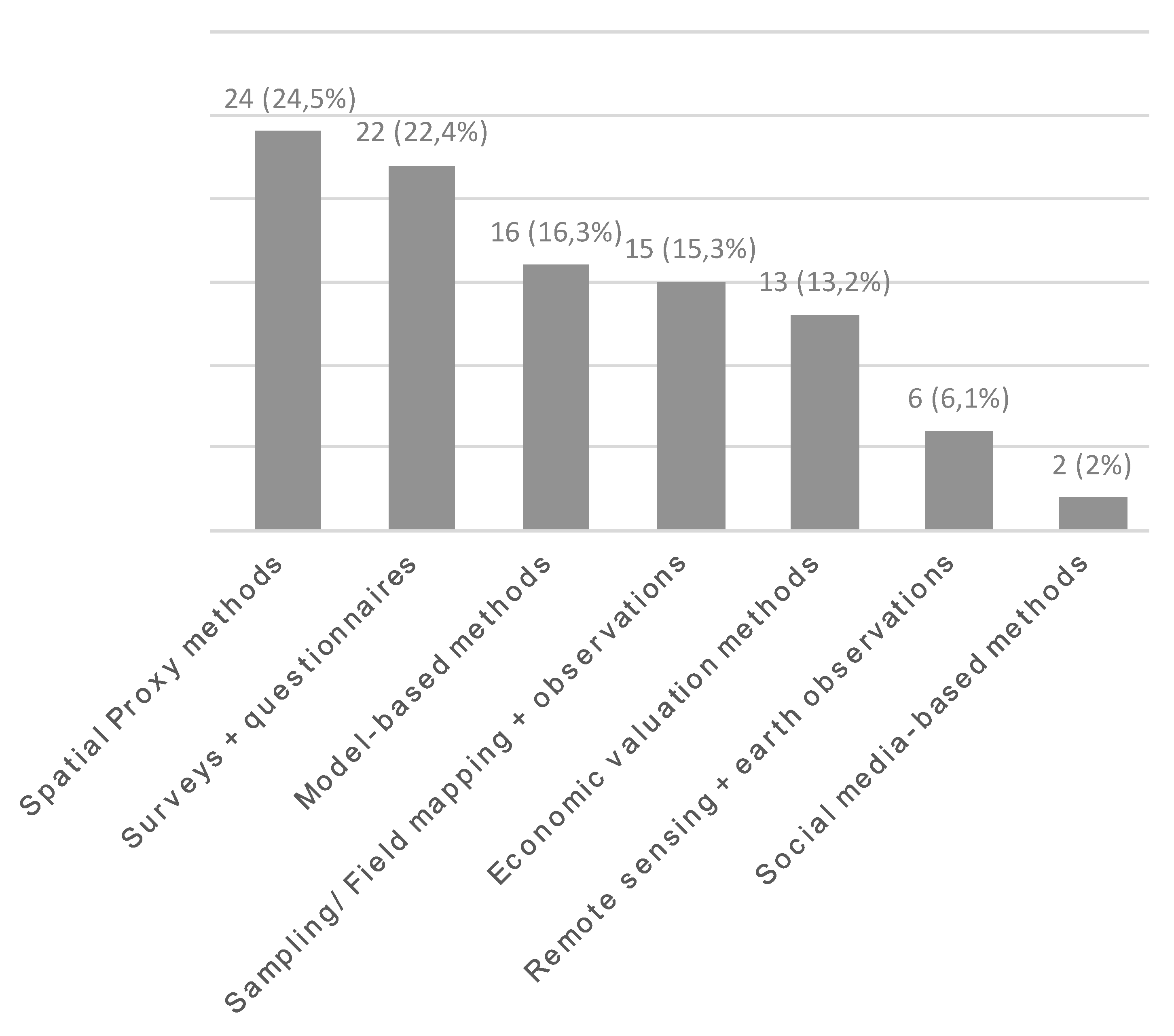From City- to Site-Dimension: Assessing the Urban Ecosystem Services of Different Types of Green Infrastructure
Abstract
1. Introduction
2. Materials and Methods
2.1. Review Approach
- The article should be written in English and published sometime between 2000 (chosen to reflect Bolund and Hunhammer’s article of 1999 [3], which was the first to write about “urban ecosystem services”) and April 2019;
- The article should explicitly address “urban ecosystem services”;
- The article should deal directly with the assessment or valuation of urban ES (the studies should not merely map urban ES);
- The study should examine larger and smaller scale green infrastructure types or land use types in cities such as parks, gardens or single trees.
2.2. Analysis Approach of Included Articles
3. Results
3.1. General Overview of Articles
3.2. Assessed Es of Urban Green Infrastructure Types
3.3. Investigated Green Infrastructure Types and Dimensions
3.4. Methods Used to Assess the Urban Es of Green Infrastructure Types
4. Discussion
5. Conclusions
Supplementary Materials
Author Contributions
Funding
Acknowledgments
Conflicts of Interest
References
- United Nations. World Urbanization Prospects: The 2018 Revision (ST/ESA/SER.A/420); United Nations, Department of Economic and Social Affairs, Population Division: New York, NY, USA, 2019. [Google Scholar]
- IPCC SRCCL. Climate Change and Land. An IPCC Special Report on Climate Change, Desertification, Land Degradation, Sustainable Land Management, Food Security, and Greenhouse Gas Fluxes in Terrestrial Ecosystems. Summary for Policymakers: 2019; Approved Draft, Genf, Switzerland. Available online: https://www.ipcc.ch/srccl/ (accessed on 13 May 2020).
- Bolund, P.; Hunhammer, S. Ecosystem Services in Urban Areas. Ecol. Econ. 1999, 29, 293–301. [Google Scholar] [CrossRef]
- Gómez-Baggethun, E.; Barton, D.N. Classifying and Valuing Ecosystem Services for Urban Planning. Ecol. Econ. 2013, 86, 235–245. [Google Scholar] [CrossRef]
- Haase, D.; Fantzeskaki, N.; Elmqvist, T. Ecosystem Services in Urban Landscapes: Practical Applications and Governance Implications. AMBIO 2014, 43, 407–412. [Google Scholar] [CrossRef] [PubMed]
- United Nations. World Urbanization Prospects: The 2014 Revision, Highlights; United Nations, Department of Economic and Social Affairs, Population Division: New York, NY, USA, 2014. [Google Scholar]
- Communication from the Commission to the European Parliament, the Council, the European Economic and Social Committee and the Committee of the Regions. In Green Infrastructure (GI)—Enhancing Europe’s Natural Capital—COM (2013) 249; European Commission: Brussels, Belgium, 2013; p. 149.
- Burkhard, B.; Kroll, F.; Nedkov, S.; Müller, F. Mapping Ecosystem Service Supply, Demand and Budgets. Ecol. Indic. 2012, 21, 17–29. [Google Scholar] [CrossRef]
- Demuzere, M.; Orru, K.; Heidrich, O.; Olazabal, E.; Geneletti, D.; Orru, H.; Bhave, A.G.; Mittal, N.; Feliu, E.; Faehnle, M. Mitigating and Adapting to Climate Change: Multi-functional and Mulit-Scale Assessment of Green Urban Infrastructure. J. Environ. Manag. 2014, 146, 107–115. [Google Scholar] [CrossRef]
- Niemelä, J.; Saarela, S.R.; Soderman, T.; Kopperoinen, L.; Yli-Pelkonen, V.; Vare, S.; Kotze, D.J. Using the Ecosystem Services Approach for Better Planning and Conservation of Urban Green Spaces. A Finland case study. Biodivers. Conserv. 2010, 19, 3225–3243. [Google Scholar] [CrossRef]
- Pauleit, S.; Liu, L.; Ahern, J.; Kazmierczak, A. Multifunctional Green Infrastructure Planning to Promote Ecological Services in the City. In Urban Ecology. Patterns, Processes, and Applications; Niemelä, J., Ed.; Oxford Univnversity Press: Oxford, UK, 2011; pp. 272–285. [Google Scholar] [CrossRef]
- Radford, K.G.; James, P. Changes in the Value of Ecosystem Services along a Rural-Urban Gradient: A case study of Greater Manchester, UK. Landsc. Urban Plan. 2013, 109, 117–127. [Google Scholar] [CrossRef]
- Artmann, M.; Bastian, O.; Grunewald, K. Using the Concepts of Green Infrastructure and Ecosystem Services to Specify Leitbilder for Compact and Green Cities—The Example of the Landscape Plan of Dresden (Germany). Sustainability 2017, 9, 198. [Google Scholar] [CrossRef]
- Haase, D.; Larondelle, N.; Andersson, E.; Artmann, M.; Borgström, S.; Breuste, J.; Gomez-Baggethun, E.; Gren, A.; Hamstead, Z.; Hansen, R.; et al. A Quantitative Review of Urban Ecosystem Service Assessments: Concepts, Models, and Implementation. AMBIO 2014, 43, 413–433. [Google Scholar] [CrossRef]
- Wende, W. Ecosystem Services and Landscape Planning. How to lntegrate Two Different Worlds in a High-Density Urban Setting. In Urban Landscapes in High—Density Cities; Rinaldi, B.M., Tan, P.J., Eds.; Birkhäuser: Berlin, Germany; Birkhäuser: Basel, Switzerland, 2019; pp. 154–164. [Google Scholar] [CrossRef]
- Grunewald, K.; Richter, B.; Behnisch, M. Multi-Indicator Approach for Characterising Urban Green Space Provision at City and City-District Level in Germany. Int. J. Environ. Res. Public Health 2019, 16, 2300. [Google Scholar] [CrossRef]
- Cortinovis, C.; Geneletti, D. Ecosystem Services in Urban Plans: What is there, and what is still needed for better decisions. Land Use Policy 2018, 70, 298–312. [Google Scholar] [CrossRef]
- Kroll, F.; Müller, F.; Haase, D.; Fohrer, N. Rural-Urban Gradient Analysis of Ecosystem Services Supply and Demand Dynamics. Land Use Policy 2012, 29, 521–535. [Google Scholar] [CrossRef]
- Pandeya, B.; Buytaert, W.; Zulkafli, Z.; Karpouzoglou, T.; Mao, F.; Hannah, D.M. A Comparative Analysis of Ecosystem Services Valuation Approaches for Application at the Local Scale and in Data Scarce Regions. Ecosyst. Serv. 2016, 22, 250–259. [Google Scholar] [CrossRef]
- Wurster, D.; Artmann, M. Development of a Concept for Non-monetary Assessment of Urban Ecosystem Services at the Site Level. AMBIO 2014, 43, 454–465. [Google Scholar] [CrossRef]
- Tammi, I.; Mustajärvi, K.; Rasinmäki, J. Integrating Spatial Valuation of Ecosystem Services into Regional Planning and Development. Ecosyst. Serv. 2017, 26, 329–344. [Google Scholar] [CrossRef]
- Pickett, S.T.A.; Cadenasso, M.L.; Grove, J.M.; Nilon, C.H.; Pouyat, R.V.; Zipperer, W.C.; Costanza, R. Urban Ecological Systems: Linking Terrestrial Ecological, Physical, and Socioeconomic Components of Metropolitan Areas. Annu. Rev. Ecol. Syst. 2001, 32, 127–157. [Google Scholar] [CrossRef]
- Gómez-Baggethun, E.; Gren, A.; Barton, D.N.; Langemeyer, J.; McPhearson, T.; O’Farrell, P.; Andersson, E.; Hamstead, Z.; Kremer, P. Chapter 11: Urban Ecosystem Services. In Urbanization, Biodiversity and Ecosystem Services: Challenges and Opportunities. A Global Assessment; Elmqvist, T., Fragkias, M., Goodness, J., Güneralp, B., Marcotullio, P.J., McDonald, R.I., Parnell, S., Schewenius, M., Sendstad, M., Seto, K.C., et al., Eds.; Springer: Dordrecht, The Netherlands, 2013; pp. 175–251. [Google Scholar] [CrossRef]
- Grunewald, K.; Bastian, O. Special Issue: “Maintaining Ecosystem Services to Support Urban Needs”. Sustainabilty 2017, 9, 1647. [Google Scholar] [CrossRef]
- Beichler, S.A.; Bastian, O.; Haase, D.; Heiland, S.; Kabisch, N.; Müller, F. Does the Ecosystem Service Concept Reach its Limits in Urban Environments? Landsc. Online 2017, 51, 1–21. [Google Scholar] [CrossRef]
- Kremer, P.; Hamstead, Z.; Haase, D.; McPhearson, T.; Frantzeskaki, N.; Andersson, E.; Kabisch, N.; Larondelle, N.; Lorance Rall, E.; Voigt, A.; et al. Key Insights for the Future of Urban Ecosystem Services Research. Ecol. Soc. 2016, 21, 29. [Google Scholar] [CrossRef]
- Seppelt, R.; Dormann, C.F.; Eppink, F.V.; Lautenbach, S.; Schmidt, S. A Quantitative Review of Ecosystem Service Studies: Approaches, Shortcomings and the Road Ahead. J. Appl. Ecol. 2011, 48, 630–636. [Google Scholar] [CrossRef]
- Pickering, C.; Byrne, J. The Benefits of Publishing Systematic Quantitative Literature Reviews for PhD Candidates and other Early-Career Researchers. High. Educ. Res. Dev. 2014, 33, 534–548. [Google Scholar] [CrossRef]
- TEEB—The Economics of Ecosystems and Biodiversity. TEEB Manual for Cities: Ecosystem Services in Urban Management. 2011. Available online: www.teebweb.org (accessed on 13 May 2020).
- De Wit, M.; van Zyl, H.; Crookes, D.; Blignaut, J.; Jayiya, T.; Goiset, V.; Mahumani, B. Including the economic value of well-functioning urban ecosystems in financial decisions: Evidence from a process in Cape Town. Ecosyst. Serv. 2012, 2, 38–44. [Google Scholar] [CrossRef]
- De Wit, M.; Van Zyl, H.; Crookes, D.; Blignaut, J.; Jayiya, T.; Goiset, V.; Mahumani, B. Investing in Natural assets. A Business Case for the Environment in the City of Cape Town. Cape Town 2009. [Google Scholar] [CrossRef]
- Säumel, I.; Reddy, E.S.; Wachtel, T. Edible City Solutions—One Step Further to Foster Social Resilience through Enhanced Socio-Cultural Ecosystem Services in Cities. Sustainability 2019, 11, 972. [Google Scholar] [CrossRef]
- Buchel, S.; Frantzeskaki, N. Citizens’ Voice. A Case Study about Perceived Ecosystem Services by Urban Park Users in Rotterdam, the Netherlands. Ecosyst. Serv. 2015, 12, 169–177. [Google Scholar] [CrossRef]
- Hegetschweiler, T.; de Vries, S.; Arnberger, A.; Bell, S.; Brennan, M.; Siter, N.; Olafsson, A.; Voigt, A.; Hunziker, M. Linking Demand and Supply Factors in Identifying Cultural Ecosystem Services of Urban Green Infrastructures: A review of European studies. Urban For. Urban Green. 2017, 21, 48–59. [Google Scholar] [CrossRef]
- Graça, M.; Alves, P.; Gonçalves, J.; Nowak, J.D.; Hoehn, R.; Farinha-Marques, P.; Cunha, M. Assessing How Green Space Types Affect Ecosystem Services Delivery in Porto, Portugal. Landsc. Urban Plan. 2018, 170, 195–208. [Google Scholar] [CrossRef]
- Hernández-Morcillo, M.; Plieninger, T.; Bieling, C. An Empirical Review of Cultural Ecosystem Service Indicators. Ecol. Indic. 2013, 29, 434–444. [Google Scholar] [CrossRef]
- Mathey, J.; Rößler, S.; Banse, J.; Lehmann, I.; Bräuer, A. Brownfields as an Element of Green Infrastructure for Implementing Ecosystem Services into Urban Areas. J. Urban Plan. Dev. 2015, 141, A4015001. [Google Scholar] [CrossRef]
- Pueffel, C.; Haase, D.; Priess, J.A. Mapping Ecosystem Services on Brownfields in Leipzig, Germany. Ecosyst. Serv. 2018, 30, 73–85. [Google Scholar] [CrossRef]
- Takács, A.; Kiss, M.; Hof, A.; Tanács, E.; Gulyás, A.; Kántor, N. Microclimate Modification by Urban Shade Trees—An Integrated Approach to Aid Ecosystem Service Based Decision-Making. Procedia Environ. Sci. 2016, 32, 97–109. [Google Scholar] [CrossRef]
- Marando, F.; Salvatori, E.; Sebastiani, A.; Fusaro, L.; Manes, F. Regulating Ecosystem Services and Green Infrastructure: Assessment of Urban Heat Island Effect Mitigation in the Municipality of Rome, Italy. Ecol. Model. 2019, 392, 92–102. [Google Scholar] [CrossRef]
- Lehmann, I.; Mathey, J.; Rößler, S.; Bräuer, A.; Goldberg, V. Urban Vegetation Structure Types as a Methodological Approach for Identifying Ecosystem Services—Application to the Analysis of Micro-Climatic Effects. Ecol. Indic. 2014, 42, 58–72. [Google Scholar] [CrossRef]
- De Valck, J.; Beames, A.; Liekens, I.; Bettens, M.; Seuntjens, P.; Broekx, S. Valuing Urban Ecosystem Services in Sustainable Brownfield Redevelopment. Ecosyst. Serv. 2019, 35, 139–149. [Google Scholar] [CrossRef]
- Sun, F.; Xiang, J.; Tao, Y.; Tong, C.; Che, Y. Mapping the Social Values for Ecosystem Services in Urban Green Spaces: Integrating a Visitor-Employed Photography Method into SolVES. Urban For. Urban Green. 2019, 38, 105–113. [Google Scholar] [CrossRef]
- Vieira, J.; Matos, P.; Mexia, T.; Silva, P.; Lopes, N.; Freitas, C.; Correia, O.; Santos-Reis, M.; Branquinho, C.; Pinho, P. Green Spaces are not all the same for the Provision of Air Purification and Climate Regulation Services: The Case of Urban Parks. Environ. Res. 2018, 160, 306–313. [Google Scholar] [CrossRef]
- Ko, H.; Son, Y. Perceptions of cultural ecosystem services in urban green spaces: A case study in Gwacheon, Republic of Korea. Ecol. Indic. 2018, 91, 299–306. [Google Scholar] [CrossRef]
- Pappalardo, V.; La Rosa, D.; Campisano, A.; La Greca, P. The Potential of Green Infrastructure Application in Urban Runoff Control for Land Use Planning: A Preliminary Evaluation from a Southern Italy Case Study. Ecosyst. Serv. 2017, 26, 345–354. [Google Scholar] [CrossRef]
- Larondelle, N.; Lauf, S. Balancing Demand and Supply of Multiple Urban ecosystem Services on Different Spatial Scales. Ecosyst. Serv. 2016, 22, 18–31. [Google Scholar] [CrossRef]
- Strohbach, M.W.; Haase, D. Above-Ground Carbon Storage by Urban Trees in Leipzig, Germany: Analysis of Patterns in a European City. Landsc. Urban Plan. 2012, 104, 95–104. [Google Scholar] [CrossRef]
- Czembrowski, P.; Kronenberg, J.; Czepkiewicz, M. Integrating Non-Monetary and Monetary Valuation Methods—SoftGIS and Hedonic Pricing. Ecol. Econ. 2016, 130, 166–175. [Google Scholar] [CrossRef]
- Costanza, R.; de Groot, R.; Sutton, P.; van der Ploeg, S.; Anderson, S.J.; Kubiszewski, I.; Farber, S.; Turner, R.K. Changes in the Global Value of Ecosystem Services. Glob. Environ. Chang. 2014, 26, 152–158. [Google Scholar] [CrossRef]
- Sutton, P.; Anderson, S. Holistic Valuation of Urban Ecosystem Services in New York City’s Central Park. Ecosyst. Serv. 2016, 19, 87–91. [Google Scholar] [CrossRef]
- Speak, A.; Mizgajski, A.; Borysiak, J. Allotment Gardens and Parks: Provision of Ecosystem Services with an Emphasis on Biodiversity. Urban For. Urban Green. 2015, 14, 778–781. [Google Scholar] [CrossRef]
- Kremer, P.; Hamstead, Z.A.; McPhearson, T. The Value of Urban Ecosysten Services in New York City: A Spatially Explicit Multicriteria Analysis of Landscape Scale Valuation Scenarios. Environ. Sci. Policy 2016, 62, 57–68. [Google Scholar] [CrossRef]
- Eigenbrod, F.; Armsworth, P.R.; Anderson, B.J.; Heinemeyer, A.; Gillings, S.; Roy, D.B.; Thomas, C.D.; Gaston, K.J. The impact of proxy-based methods on mapping the distribution of ecosystem services. J. Appl. Ecol. 2010, 47, 377–385. [Google Scholar] [CrossRef]
- Richards, D.R.; Tunçer, B. Using Image Recognition to Automate Assessment of Cultural Ecosystem Services from Social Media Photographs. Ecosyst. Serv. 2018, 31, 318–325. [Google Scholar] [CrossRef]
- Parsa, V.A.; Salehi, E.; Yavari, A.R.; Van Bodegom, P.M. Analyzing Temporal Changes in Urban Forest Structure and the Effect on Air Quality Improvement. Sustain. Cities Soc. 2019, 48, 101548. [Google Scholar] [CrossRef]
- Baró, F.; Chaparro, L.; Gómez-Baggethun, E.; Langemeyer, J.; Nowak, D.J.; Terradas, J. Contribution of Ecosystem Services to Air Quality and Climate Change Mitigation Policies. The Case of Urban Forests in Barcelona, Spain. AMBIO 2014, 43, 466–479. [Google Scholar] [CrossRef]
- Graça, M.S.; Gonçalves, J.F.; Alves, P.J.M.; Nowak, D.J.; Hoehn, R.; Ellis, A.; Farinha-Marques, P.; Cunha, M. Assessing mismatches in ecosystem services proficiency across the urban fabric of Porto (Portugal): The influence of structural and socioeconomic variables. Ecosyst. Serv. 2017, 23, 82–93. [Google Scholar] [CrossRef]
- Selmi, W.; Weber, C.; Rivière, E.; Blond, N.; Mehdi, L.; Nowak, D. Air pollution removal by trees in public green spaces in Strasbourg city, France. Urban For. Urban Green. 2016, 17, 192–201. [Google Scholar] [CrossRef]
- Baró, F.; Haase, D.; Gómez-Baggethun, E.; Frantzeskaki, N. Mismatches between ecosystem services supply and demand in urban areas: A quantitative assessment in five European cities. Ecol. Indic. 2015, 55, 146–158. [Google Scholar] [CrossRef]
- Kiss, M.; Takács, Á.; Pogácsás, R.; Gulyás, A. The role of ecosystem services in climate and air quality in urban areas: Evaluating carbon sequestration and air pollution removal by street and park trees in Szeged (Hungary). Morav. Geogr. Rep. 2015, 23, 36–46. [Google Scholar] [CrossRef]
- Zepp, H.; Mizgajski, A.; Mess, C.; Zwierzchowska, I. A Preliminary Assessment of Urban Ecosystem Services in Central European Urban Areas. A Methodological Outline with Examples from Bochum (Germany) and Poznań (Poland). Berichte. Geogr. Landeskd. 2016, 90, 67–84. [Google Scholar]
- Botzat, A.; Fischer, L.K.; Kowarik, I. Unexploited Opportunities in Understanding Liveable and Biodiverse Cities. A Review on Urban Biodiversity Perception and Valuation. Glob. Environ. Chang. 2016, 39, 220–233. [Google Scholar] [CrossRef]
- Kabisch, N.; Qureshi, S.; Haase, D. Human-Environment Interactions in Urban Green Spaces—A Systematic Review of Contemporary Issues and Prospects for Future Research. Environ. Impact Assess. Rev. 2015, 50, 25–34. [Google Scholar] [CrossRef]




| Structural type | Studies that investigate a spatial pattern consisting of different types of land use typical of a city. In contrast to Neighborhood, this is not an administratively confined spatial unit, but in general reflects typical urban structures. |
| Neighborhood | Studies that focus on a part of a city as a community within the urban context, which is administratively defined and localized. |
| Urban green spaces | Studies that examine in aggregation many different green spaces (defined as any vegetated areas found in the urban landscape, e.g., parks, urban forests, lawns, home gardens, street trees). |
| Forest | Studies that investigate urban forests as ecosystems. |
| Water bodies and wetland | Studies that investigate wetlands and flowing or still waters. |
| Park | Studies that focus on (usually larger) green areas designed for recreation and landscaping. |
| Allotment/community gardens | Studies that investigate allotment or community gardens as plots of land for individual and own use to grow food. |
| Brownfield | Studies that examine areas within the residential area which were formerly used for different purposes and which are temporarily or permanently no longer used as they were originally used. |
| Trees | Studies that examine single or several trees in a city. |
| Green roof/wall | Studies that focus on different forms of building greenery. |
| ES Section | Number |
|---|---|
| Provisioning (12) | 37 |
| Regulation & Maintenance (16) | 177 |
| Cultural (9) | 115 |
| Assessed Green Infrastructure Types | ||||||||||||||||
|---|---|---|---|---|---|---|---|---|---|---|---|---|---|---|---|---|
| City-Dimension | Site-Dimension | |||||||||||||||
| ES Section | ES Class | Structural Types | Neighborhood | Urban Green Spaces | Forest | Water Bodies and Wetland | Park | Allotment/Community Garden | Brownfield | Trees | Green Roof/Wall | Neighborhood | Urban Green Spaces | Water Bodies and Wetland | Park | Trees |
| Provisioning | Cultivated terrestrial plants (incl. fungi, algae) grown for nutritional purposes | (3) | (1) | (5) | (1) | (3) | (1) | |||||||||
| Fibres and other materials from cultivated plants, fungi, algae and bacteria for direct use or processing (excluding genetic materials) | (4) | |||||||||||||||
| Cultivated plants (including fungi, algae) grown as a source of energy | (2) | |||||||||||||||
| Animals reared for nutritional purposes | (1) | |||||||||||||||
| Fibres and other materials from reared animals for direct use or processing (excluding genetic materials) | (2) | |||||||||||||||
| Wild plants (terrestrial and aquatic, including fungi, algae) used for nutrition | (1) | (1) | ||||||||||||||
| Fibres and other materials from wild plants for direct use or processing (excluding genetic materials) | (1) | (1) | ||||||||||||||
| Wild animals (terrestrial and aquatic) used for nutritional purposes | (1) | |||||||||||||||
| Fibres and other materials from wild animals for direct use or processing (excluding genetic materials) | (1) | |||||||||||||||
| Surface water for drinking | (1) | (1) | ||||||||||||||
| Surface water used as a material (non-drinking purposes) | (1) | |||||||||||||||
| Ground (and subsurface) water for drinking | (1) | (1) | (1) | |||||||||||||
| Provisioning services (in general, specifications missing) | (1) | (1) | ||||||||||||||
| Regulation & Maintenance | Filtration/sequestration/storage/accumulation by micro-organisms, algae, plants, and animals | (6) | (2) | (14) | (1) | (1) | (2) | (1) | (8) | (1) | (3) | (2) | (3) | (1) | ||
| Noise attenuation | (3) | (1) | (2) | (1) | (1) | (1) | ||||||||||
| Control of erosion rates | (1) | (2) | (1) | |||||||||||||
| Hydrological cycle and water flow regulation (Including flood control, and coastal protection) | (4) | (7) | (3) | (1) | (3) | (1) | (2) | (1) | (1) | |||||||
| Wind protection | (1) | |||||||||||||||
| Fire protection | (1) | |||||||||||||||
| Pollination (or 'gamete' dispersal in a marine context) | (4) | (3) | (1) | (2) | ||||||||||||
| Seed dispersal | (2) | (1) | ||||||||||||||
| Maintaining nursery populations and habitats (Including gene pool protection) | (4) | (6) | (1) | (1) | (1) | (4) | (1) | (1) | (1) | (1) | ||||||
| Pest control (including invasive species) | (1) | |||||||||||||||
| Disease control | (1) | |||||||||||||||
| Weathering processes and their effect on soil quality | (1) | |||||||||||||||
| Decomposition and fixing processes and their effect on soil quality | (1) | (3) | (3) | |||||||||||||
| Regulation of the chemical condition of freshwaters by living processes | (1) | (1) | (1) | (1) | ||||||||||||
| Regulation of chemical composition of atmosphere and oceans | (4) | (1) | ||||||||||||||
| Regulation of temperature and humidity, including ventilation and transpiration | (7) | (2) | (11) | (1) | (1) | (2) | (2) | (1) | (5) | (2) | (1) | (1) | (2) | (1) | ||
| Regulation & maintenance services (in general, specifications missing) | (1) | (1) | ||||||||||||||
| Cultural | Characteristics of living systems that that enable activities promoting health, recuperation or enjoyment through active or immersive interactions | (5) | (2) | (10) | (3) | (2) | (1) | (1) | (1) | (2) | (2) | (1) | ||||
| Characteristics of living systems that enable activities promoting health, recuperation or enjoyment through passive or observational interactions | (3) | (2) | (10) | (3) | (2) | (1) | (1) | (1) | (1) | (2) | (1) | |||||
| Characteristics of living systems that enable scientific investigation or the creation of traditional ecological knowledge | (3) | (1) | (1) | (1) | (1) | |||||||||||
| Characteristics of living systems that enable education and training | (2) | (1) | (1) | (1) | ||||||||||||
| Characteristics of living systems that are resonant in terms of culture or heritage | (4) | (2) | (1) | |||||||||||||
| Characteristics of living systems that enable aesthetic experiences | (3) | (7) | (2) | (1) | (1) | |||||||||||
| Elements of living systems that have sacred or religious meaning | (1) | (3) | (1) | |||||||||||||
| Elements of living systems used for entertainment or representation | (1) | (3) | (1) | (1) | ||||||||||||
| Other (Communication and interaction with other people) | (2) | (1) | (1) | |||||||||||||
| Cultural services (in general, specifications missing) | (1) | (1) | (1) | (2) | (2) | (1) | (1) | (1) | ||||||||
| Assessed Small-Scale Structures | |||||||||||||||
|---|---|---|---|---|---|---|---|---|---|---|---|---|---|---|---|
| City-Dimension | Site-Dimension | ||||||||||||||
| Method Categories | Structural Types | Neighborhood | Urban Green Spaces | Forest | Water Bodies and Wetland | Park | Allotment/Community Garden | Brownfield | Trees | Green Roof/Wall | Neighborhood | Urban Green Spaces | Water Bodies and Wetland | Park | Trees |
| Spatial Proxy methods | (5) | (7) | (1) | (3) | (1) | (2) | (1) | (2) | (1) | (1) | |||||
| Sampling/Field mapping + observations | (2) | (3) | (2) | (3) | (1) | (2) | (2) | (1) | |||||||
| Surveys and questionnaires | (2) | (7) | (2) | (3) | (3) | (1) | (1) | (3) | (1) | ||||||
| Economic valuation methods | (2) | (4) | (1) | (2) | (1) | (1) | (2) | ||||||||
| Model-based methods | (2) | (1) | (7) | (1) | (5) | (2) | (1) | ||||||||
| Social media-based methods | (1) | (1) | |||||||||||||
| Remote sensing and earth observations | (1) | (1) | (3) | (1) | |||||||||||
© 2020 by the authors. Licensee MDPI, Basel, Switzerland. This article is an open access article distributed under the terms and conditions of the Creative Commons Attribution (CC BY) license (http://creativecommons.org/licenses/by/4.0/).
Share and Cite
Brzoska, P.; Spāģe, A. From City- to Site-Dimension: Assessing the Urban Ecosystem Services of Different Types of Green Infrastructure. Land 2020, 9, 150. https://doi.org/10.3390/land9050150
Brzoska P, Spāģe A. From City- to Site-Dimension: Assessing the Urban Ecosystem Services of Different Types of Green Infrastructure. Land. 2020; 9(5):150. https://doi.org/10.3390/land9050150
Chicago/Turabian StyleBrzoska, Patrycia, and Aiga Spāģe. 2020. "From City- to Site-Dimension: Assessing the Urban Ecosystem Services of Different Types of Green Infrastructure" Land 9, no. 5: 150. https://doi.org/10.3390/land9050150
APA StyleBrzoska, P., & Spāģe, A. (2020). From City- to Site-Dimension: Assessing the Urban Ecosystem Services of Different Types of Green Infrastructure. Land, 9(5), 150. https://doi.org/10.3390/land9050150




